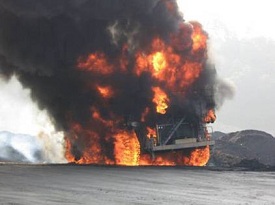 Heavy equipment fires occur frequently and can lead to substantial losses. The loss of the equipment itself is often compounded by the insured’s loss of use of the equipment. For businesses that rely extensively on heavy equipment (e.g., agricultural and construction businesses), the loss of use/business interruption claim arising from such a fire can be staggering.
Heavy equipment fires occur frequently and can lead to substantial losses. The loss of the equipment itself is often compounded by the insured’s loss of use of the equipment. For businesses that rely extensively on heavy equipment (e.g., agricultural and construction businesses), the loss of use/business interruption claim arising from such a fire can be staggering.
Heavy equipment is often used in undeveloped areas not readily accessible to fire departments. As a result, the equipment is often badly damaged by the fire, creating challenges to identifying the point of origin. Subrogation recovery for such fire will hinge on proper investigation immediately after the loss occurs. The following are some tips to guide a subrogating carrier’s investigation in heavy equipment fires.
In analyzing a heavy equipment fire case, it is important to gather data and evaluate the maintenance history of the equipment. Lack of maintenance of hoses carrying hydraulic fluid can be problematic, as these rubber hoses become brittle and prone to cracking over time, creating the potential for the failed hose to discharge pressurized, flammable hydraulic fluid onto hot parts of the equipment’s motor or exhaust system, resulting in a fire. Thus, one of the first steps in evaluating the recovery potential of a heavy equipment fire claim is to determine whether the equipment was properly maintained. A diligent insured will keep log books recording each instance of maintenance to the equipment. The carrier should request such maintenance records from the insured at the outset of such a claim, as those records can substantially inform the subsequent investigation.
Additionally, some heavy equipment fires may occur at job sites where there is already a fire in progress. In a land clearing project, for instance, there is usually a pile of cleared wood and vegetation being burned. This creates a significant potential for the equipment operator to move the equipment too close to the burn pile, causing combustible components of the equipment to ignite. On many pieces of equipment, the cold air intake is located at the rear of the machine, behind the operator. We have investigated several fires wherein the operator, looking forward, did not realize that the rear of the machine was perilously close to a burning debris pile, and a smoldering ember is sucked into the machine’s cold air intake, causing a fire in the engine compartment. This potential fire cause makes it crucial that the subrogating carrier establish the pre-fire location and movements of the equipment as soon as possible following a loss. The carrier should make every effort to obtain this information directly from the operator of the equipment and other individuals who were actually present when the fire occurred; obtaining the information from a foreman or company representative who was not present at the time of the loss is not a substitute for first-hand statements.
Finally, the carrier should be aware that not all fire investigators and engineers are created equal for purposes of investigating a heavy equipment fire. If possible, the subrogating carrier should retain a fire investigator familiar with heavy equipment fires and a mechanical or electrical engineer who specializes in heavy equipment, as non-specialist fire investigators and engineers may not be able to quickly and accurately identify all potential ignition sources on the relevant equipment.



